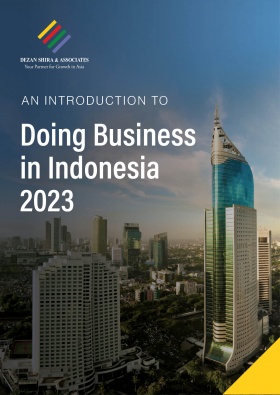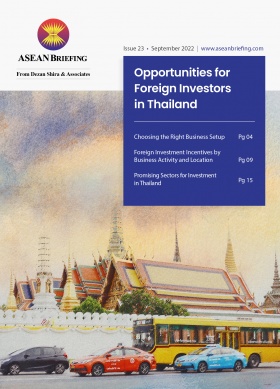How to Set Up a Company in Indonesia
In this article, we discuss how to set up a company in Indonesia, including the steps to establish a limited liability company.
Indonesia’s government has sought to simplify the corporate establishment process through Government Regulation in Lieu of Law No. 2 of 2022, which has amended several aspects of the corporate establishment process and norms of doing business in Indonesia.
Based on the Investment Coordinating Board of the Republic Indonesia Regulation No. 4 of 2021 (BKPM Reg 4/2021), the minimum capital requirement for a foreign investment company or PT PMA shall be a total investment of at least 10 billion rupiah (US$696,000). Previously, the minimum capital requirement for a PT PMA was 2.5 billion rupiah (US$167,065).
Further, the government has also implemented a new risk-based approach to the issuance of business licenses. Business activities will be assessed on the scale of the hazards they can potentially create (low risk, medium-low risk, medium-high risk, and high risk).Previously, foreign businesses had to endure multi-layered bureaucratic structures that involved multiple local and federal authorities, making it difficult for investors to determine which business licenses to obtain.
The Positive investment list
Presidential Regulation 10 of 2021 as amended to President Regulation No. 49 of 2021 (PR 49/2021) liberalizes many business sectors for foreign investment. Dubbed the positive investment list, PR 49/2021 liberalizes over 200 business lines, including transportation, energy, and telecommunication.
The general principle under the positive investment list is that a business sector is open to 100 percent foreign investment unless it is subjected to a specific type of limitation. The regulation presents one of the greatest liberalizations in foreign ownership limitations in Indonesia since the negative investment list was first introduced in the 1980s.
The government has classified business fields into four categories.
- Priority sectors;
- Business fields that stipulate specific requirements or limitations;
- Businesses fields open to large enterprises, including foreign investors, but are subject to a compulsory partnership with cooperatives and micro, small, and medium-sized enterprises (MSMEs); and
- Business fields that are fully open to foreign investment.
What are the advantages of a PT PMA?
There are several advantages of PT PMAs, including:
- Special financial and non-financial incentives, particularly in pioneer industries;
- Incentives for setting up in special economic zones (SEZs);
- Foreign investors can own as little as one percent and as much as 100 percent of the company (depending on the industry);
- Able to participate in government-sponsored business tenders in the country;
- Ease of processing for business licenses;
- Ease of processing for work permits;
- Lower tax and import duties;
- Simple organization structure (requiring only one director, one commissioner, and two shareholders); and
- Ability to sponsor foreign executives.
There are no restrictions on where the PT PMA can be set up in the country, but the business can only focus on one specific sector or area.
Set up requirements for a foreign investment company
According to BKPM Reg 4/2021, investors looking to incorporate a PT PMA need to adhere to the following requirements:
- A minimum paid-up capital of 10 billion rupiah (US$696,000) to cover operational activity;
- Appointment of two shareholders (these can be foreign individuals or corporations – the percentage of local involvement will depend on the foreign ownership limitation based on the Positive Investment List);
- The appointment of at least one commissioner and a director (these can be held by foreign individuals), although it is advisable to have one local director for the ease of administration; and
- The director will be responsible for running the day-to-day activities of the company.
Set up process for a PT PMA
- Reserve a company name with the Ministry of Law and Human Rights (which should not be similar to the name of other companies or contain vulgar language), Further the company name shall consist of three words and can be in English.
- Determine the industrial business classification code (KBLI) based on the intended business activities.
- Establish a legal entity with the company’s activities stated in the Deed of Establishment (this must be done with a local notary and the Deed of Establishment will have to be ratified by the Ministry of Law and Human Rights).
- Obtain a taxpayer identification number from the local tax office and a domicile letter from the district government (businesses established in Jakarta do not require a domicile letter).
- Obtain a tax registration certificate through the tax office where the business is domiciled.
- Obtain a Business Identification Number (NIB) by applying through the Online Single Submission (OSS) system. The NIB functions as the company’s import identification number, customs ID, and registration certificate. Further, the NIB will also automatically register your company under the government’s health and social security scheme.
- Some companies may need to apply for additional business licenses (such as for mining and fintech). Business licenses will now be issued based on the assessment of the ‘business risk level’ determined by the scale of hazards a business can potentially create.
Risk-Based Business Licensing
Government Regulation 5 of 2021 (GR 5/2021) — an implementing regulation of the Omnibus Law — introduces new criteria on how business licenses are issued in the country.
Business licenses will now be issued based on the assessment of ‘business risk level’, determined by the scale of hazards a business can potentially create.
To determine the risk level, the government will conduct a risk analysis of each application before deciding on issuing a business license. This will comprise of:
- Identifying the relevant business activity;
- Assessing the hazard level;
- Assessing the potential occurrence of hazards;
- Determining the risk level and business scale rating; and
- Determining the type of business license.
Based on the aforementioned risk analysis, the businesses activities undertaken by the applicant company will be classified into one of the following types:
- Low-risk businesses;
- Medium-low risk businesses;
- Medium-high risk businesses; and
- High-risk businesses.
Based on this risk-based approach, the lower the business risk, the simpler the business licensing requirements will be.
What sectors will be impacted?
The government will undertake the risk-analysis for business activities in the following sectors:
- Maritime affairs and fisheries;
- Agriculture;
- The environment and forestry;
- Energy and mineral resources;
- Nuclear energy;
- Industry;
- Trading;
- Public works and housing;
- Transport;
- Health, medicine, and food;
- Education and culture;
- Tourism;
- Religious affairs;
- Post, telecommunications, broadcasting, and electronic system, and transactions;
- Defense; and
- Employment.
What are the requirements to obtain a business license?
The requirements vary depending on the risk level of the business with those in the high-risk categories requiring more permits and licenses.
The first stage of the process is obtaining a NIB through the OSS system. To register for a NIB, businesses will need to provide the following information:
- Taxpayer number (Nomor Pokok Wajib Pajak– NPWP);
- Business activity code according to the KBLI;
- Business profile;
- The capital structure of the business; and
- The proposed location of the business.
Furthermore, the OSS system will be linked to all relevant ministries, such as the Ministry of Finance, the Ministry of Home Affairs, and the Ministry of Law and Human Rights.
Low-risk business activities
Low-risk business activities are only required to obtain an NIB to commence their operations. In addition to serving as the formal identity of the business, the NIB also serves as a company’s import identification number, as well as the number for registering with the national social insurance program.
Medium-low risk business activities
Business activities in this category must obtain a NIB and Certificate of Standards before beginning operations. A Certificate of Standards is a statement of the fulfillment of certain business or product standards, which must be filled in through the OSS system.
The NIB allows the business to conduct activities from ‘preparation to the ‘commercial stage’.
The preparation stage includes:
- The procurement of tools or facilities;
- Land acquisition;
- Recruitment of manpower;
- Feasibility studies; and
- Financing operations for the construction phase.
The commercial stage includes:
- The production of goods/services;
- Distribution of goods/services;
- Marketing of goods/services; and
- Other commercial activities.
Medium-high risk business activities
For medium-high risk business activities, companies will need to obtain a NIB and Certificate of Standards. However, the certificate will need to be verified by the central or regional government.
A company with a NIB and an ‘unverified’ Certificate of Standards is only permitted to conduct activities deemed in the preparation stage of operations.
Once the central or regional government is satisfied the business has fulfilled the specific business standards, they will issue the ‘verified’ certificate and the company can begin the commercial stage of operations.
High-risk business activities
High-risk business activities will require a NIB and a license to operate. The license will be issued once the business has fulfilled certain conditions and verifications set out by the central or regional government, which may include an environmental impact analysis.
The NIB, however, allows the business to conduct activities in the preparation stage of operations.
Depending on the products or services being provided, businesses may have to obtain other supporting licenses to conduct commercial activities regardless of what risk level their activities are classified as.
A note on the local limited liability company
Foreign investors who want to operate a local limited liability company (PT PDMN) should understand that this can carry legal uncertainties as a PT PDMN can only be owned by Indonesian citizens.
According to Article 33 of the Investment Law of 2007, foreign investors are prohibited from making an agreement that states the share/ joint ownership in a company is on behalf of another party. Also known as a ‘nominee agreement’, foreign investors have used such arrangements to avoid regulations and requirements that apply to them.
This carries inherent risks as the local shareholders will have full control of the business and the foreign investors’ rights will not be recognized by the law.
Foreign investors who cannot afford to establish a PT PMA can engage in joint ventures or partnerships with domestic firms. This will also enable investors to enter industries that are restrictive for foreign ownership without having to face the legal ramifications.
Another option would be to buy an established PT PDMN, but this entity would need to be converted to a PT PMA. This would also mean having paid-up capital of 10 billion Rupiah (US$696,000).
About Us
ASEAN Briefing is produced by Dezan Shira & Associates. The firm assists foreign investors throughout Asia and maintains offices throughout ASEAN, including in Singapore, Hanoi, Ho Chi Minh City, and Da Nang in Vietnam, in addition to Jakarta, in Indonesia. We also have partner firms in Malaysia, the Philippines, and Thailand as well as our practices in China and India. Please contact us at asean@dezshira.com or visit our website at www.dezshira.com.
- Previous Article Singapore and EU Sign Digital Trade Agreement
- Next Article UK Joins the CPTPP: Opportunities for British Investors in Malaysia








